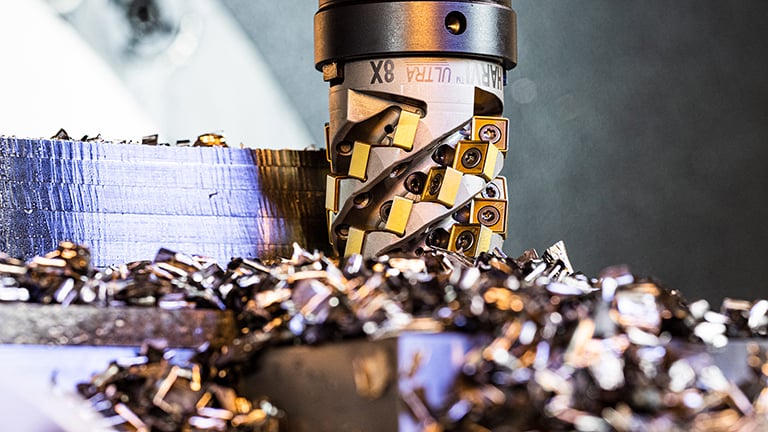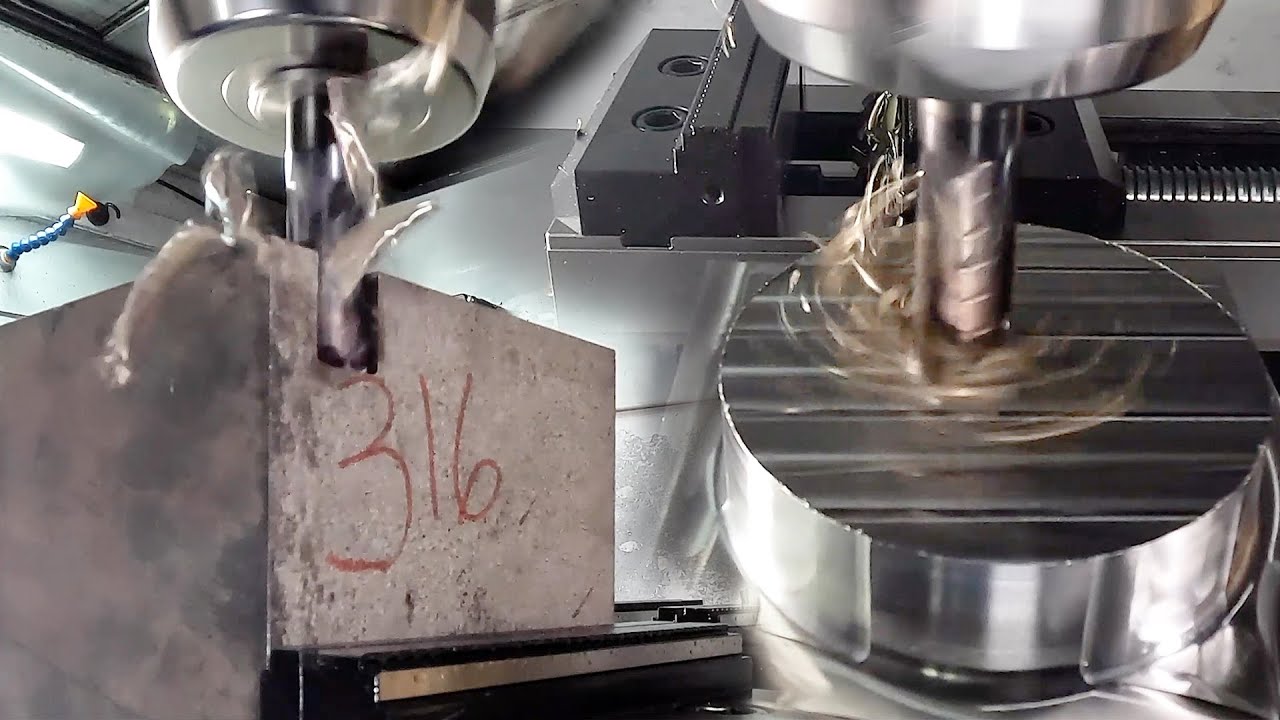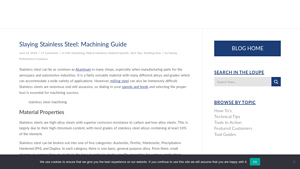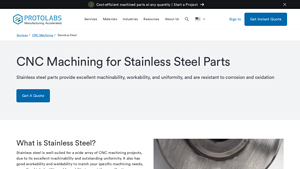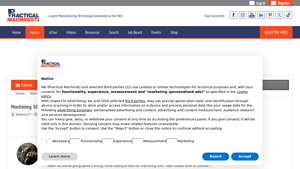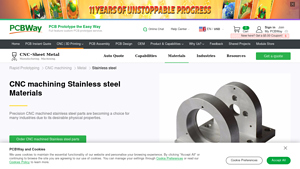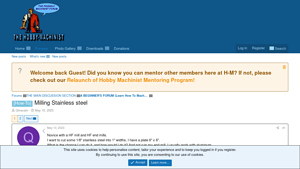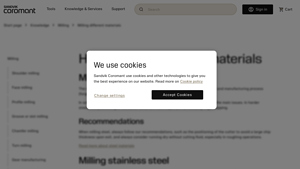Stainless Steel Milling Guide: Type, Cost, Top List…
Introduction: Navigating the Global Market for stainless steel milling
Navigating the intricate landscape of stainless steel milling poses distinct challenges for international B2B buyers. With the growing demand for high-quality, durable parts across diverse industries, sourcing reliable milling solutions can be daunting. This guide aims to demystify the complexities of stainless steel milling by providing actionable insights into types, applications, supplier vetting processes, and cost considerations.
From the corrosion-resistant properties of austenitic stainless steels to the heat-treated toughness of martensitic grades, understanding the nuances of each type is imperative for making informed decisions. Buyers will gain access to expert recommendations on the best machining techniques and tools tailored to specific applications, ensuring efficiency and quality throughout their projects. Additionally, this resource will empower businesses in regions such as Africa, South America, the Middle East, and Europe—including powerhouse markets like Brazil and Germany—to strategically approach the procurement process, mitigate risks, and enhance their supply chain effectiveness.
Ultimately, this comprehensive guide serves as a vital tool for B2B buyers aiming to optimize their operations in the global market for stainless steel milling, ensuring they can meet their production goals with confidence and precision.
Understanding stainless steel milling Types and Variations
| Type Name | Key Distinguishing Features | Primary B2B Applications | Brief Pros & Cons for Buyers |
|---|---|---|---|
| Austenitic Stainless Steel | Non-magnetic, excellent corrosion resistance | Aerospace, automotive, pharmaceuticals | Pros: High ductility; versatile applications. Cons: Not heat treatable, may be costlier. |
| Ferritic Stainless Steel | Magnetic, moderate toughness | Kitchenware, automotive parts, industrial tools | Pros: Cost-effective; good resistance to stress corrosion. Cons: Limited weldability and ductility. |
| Martensitic Stainless Steel | Heat treatable for higher hardness, magnetic | Surgical instruments, dental tools, cutlery | Pros: Strong and hard, suitable for precision tools. Cons: Prone to corrosion; requires careful machining. |
| Duplex Stainless Steel | Combination of austenitic and ferritic structures | Oil and gas, chemical processing, architectural | Pros: High strength, good corrosion resistance. Cons: More complex to machine; requires specialized tooling. |
| Precipitation Hardened Steel | Enhanced mechanical properties through aging | Aerospace, high-stress applications | Pros: High strength-to-weight ratio. Cons: Higher costs; specific heat treatment required for best performance. |
What Are the Key Characteristics of Austenitic Stainless Steel Milling?
Austenitic stainless steel, known for its non-magnetic and highly ductile properties, is the most widely used type in stainless steel milling. Composed mainly of iron, chromium, and nickel, it offers exceptional corrosion resistance and is not hardenable through heat treatment. B2B buyers in industries like aerospace and pharmaceuticals should consider this material for its versatility in applications such as tanks, piping, and various structural components. However, the non-heat-treatable nature may lead to considerations around costs and milling methods, as more robust tooling may be needed for effective processing.
How Do Ferritic Stainless Steels Differ in Milling Applications?
Representing a significant category of stainless steel, ferritic stainless steels are characterized by their magnetic properties and medium toughness. With a composition that typically minimizes nickel, they offer sufficient corrosion resistance and stress corrosion cracking resistance, making them suitable for automotive and kitchenware applications. Buyers should evaluate cost-effectiveness when selecting ferritic stainless steel; however, they should also account for challenges in weldability and ductility. Specific applications may require testing to ensure suitability, especially when precision engineering is involved.
What Are the Advantages of Martensitic Stainless Steel in Milling?
Martensitic stainless steel, recognized for its high hardness and strength, can be heat treated to enhance its mechanical properties. This makes it the go-to choice for precision instruments like surgical tools and cutlery. B2B purchasers looking for performance in high-stress environments may find martensitic alloys beneficial. However, the trade-off includes a susceptibility to corrosion, necessitating careful handling and maintenance. Understanding the specific grade and intended application is crucial to promote optimal performance as well as longevity in various high-demand applications.
What Makes Duplex Stainless Steel a Versatile Choice for Milling?
Characterized by a combination of austenitic and ferritic properties, duplex stainless steel is known for its high strength and corrosion resistance. This alloy’s structure allows it to perform well in harsh environments, such as oil and gas industries or chemical processing applications. B2B buyers in these sectors should note that while duplex steel delivers enhanced performance, it often requires specialized tooling and milling strategies, making it a consideration for those invested in durability and reliability. Despite its higher complexity in manufacturing, the long-term benefits may justify the initial investment.
Why Consider Precipitation Hardened Steel for High-Stress Applications?
Precipitation hardened stainless steel stands out due to its enhanced mechanical properties that result from aging processes. This type is well-suited for applications that demand superior strength-to-weight ratios, such as aerospace components. B2B buyers should be aware of the additional costs and specific heat treatment processes required to optimize its properties. However, for critical applications requiring high performance under stress, the investment may yield significant returns, reinforcing its utility in specialized sectors. Proper assessment of tooling and manufacturing techniques is essential to capitalize on its advantages effectively.
Key Industrial Applications of stainless steel milling
| Industry/Sector | Specific Application of stainless steel milling | Value/Benefit for the Business | Key Sourcing Considerations for this Application |
|---|---|---|---|
| Aerospace | Machining of aircraft components like brackets and fittings | Enhanced strength-to-weight ratio, corrosion resistance | Compliance with strict aerospace regulations and standards |
| Food Processing | Fabrication of processing equipment like mixers and hoppers | Hygiene and corrosion resistance, longer lifespan | Certifications for food safety and quality assurance |
| Automotive | Production of engine components such as valves and housings | Improved durability and performance | Ability to deliver precision parts under global supply chains |
| Medical Devices | Manufacturing surgical instruments and implants | High biocompatibility and stringent quality controls | Certification in international standards (e.g., ISO 13485) |
| Energy Sector | Creation of components like valves and fittings for pipelines | High resistance to corrosion in harsh environments | Assessing material grades suited for specific operating conditions |
How Is Stainless Steel Milling Used in Aerospace Components?
In the aerospace industry, stainless steel milling is crucial for producing lightweight yet strong components, such as brackets and fittings. These parts endure high-stress conditions and corrosive environments, necessitating high corrosion resistance and reliability. Buyers must prioritize suppliers who comply with strict aerospace regulations and certifications to ensure the durability and safety of these components while adhering to international standards, especially prevalent in Europe and the Middle East.
What Role Does Stainless Steel Milling Play in Food Processing Equipment?
Stainless steel milling serves a vital function in the food processing sector by fabricating equipment like mixers, hoppers, and conveyors, which require both durability and hygiene. The inherent corrosion resistance of stainless steel is essential for maintaining product quality and safety. International buyers from regions such as Africa and South America need to ensure that their suppliers meet food safety certifications and hygiene standards, providing equipment that meets or exceeds local regulatory requirements.
How Is Stainless Steel Milling Essential in Automotive Component Production?
In automotive manufacturing, stainless steel milling is employed in creating engine components, valve housings, and other critical parts. The high strength and durability of stainless steel allow for performance optimizations and prolonged part lifecycle, making it a preferred material for reducing vehicle weight without compromising strength. B2B buyers, particularly in regions like Brazil and Germany, should be aware of the intricacies of supply chains to ensure timely delivery of precision-engineered parts that meet their specific operational requirements and standards.
Why Is Stainless Steel Milling Important for Medical Devices?
Milling stainless steel for medical devices involves the creation of surgical instruments and implants that demand exceptional biocompatibility and exacting quality controls. The application of stainless steel ensures instruments maintain their integrity and performance in sterile environments. International buyers, especially from Europe and the Middle East, need to work with manufacturers that hold certifications such as ISO 13485, ensuring compliance with the stringent requirements needed for medical devices.
How Does Stainless Steel Milling Support the Energy Sector?
In the energy sector, stainless steel milling allows for the creation of critical components like valves and fittings for pipelines, which must withstand high-pressure and corrosive substances. This makes stainless steel an ideal choice due to its superior corrosion resistance and durability. Buyers must assess their suppliers’ capabilities to deliver the appropriate grades of stainless steel tailored to the harsh operational conditions typical in energy applications, primarily focusing on resilience and compliance with international standards.
3 Common User Pain Points for ‘stainless steel milling’ & Their Solutions
Scenario 1: Struggling with Tool Wear and Breakage During Milling
The Problem:
A common challenge faced by B2B buyers in the stainless steel milling sector is significant tool wear and breakage. As stainless steel is notorious for its toughness and hardening properties, many manufacturers find that standard milling tools fail to perform, leading to increased production costs and delays. This is particularly problematic for industries that require high volumes of precision-finished components, like aerospace and automotive. The inability to achieve consistent part quality due to frequent tool replacements can erode customer trust and competitive edge.
The Solution:
To tackle tool wear issues, it’s essential to invest in high-quality, specialized tooling designed for stainless steel milling. Buyers should seek tools with advanced coatings, like TiAlN or AlTiN, which enhance heat resistance and reduce friction during machining. Choosing tools with optimized geometries, such as 5 to 7 flutes for finishing operations, can improve chip evacuation, thereby reducing chip build-up and heat generation. Additionally, implementing adaptive machining techniques that involve varying speeds and feeds based on real-time tool performance can prolong tool life. Partnering with suppliers that provide comprehensive tool usage data and recommendations can further enhance operational efficiency.
Scenario 2: Navigating Insufficient Machining Parameters for Different Grades
The Problem:
Stainless steel encompasses various grades, each with distinct machining characteristics. B2B buyers often face difficulties determining the correct parameters for machining different stainless steel alloys, which can result in poor surface finishes and dimensional inaccuracies. For example, machining austenitic grades like 316 requires different feeds and speeds compared to martensitic grades like 410. This lack of understanding can lead to wasted materials and increased rework time, affecting overall production timelines and costs.
The Solution:
To improve grade-specific machining outcomes, buyers should develop a standardized machining guideline that outlines recommended parameters for each stainless steel grade they utilize. This can be established through collaboration with tooling suppliers who offer technical support and milling data. Additionally, investing in simulation software can aid in creating virtual machining scenarios, allowing engineers to test various parameters without wasting physical resources. Regular training on the unique properties of different stainless steel grades will equip technicians and operators with the knowledge needed to optimize machining operations effectively.
Scenario 3: Overcoming Challenges in Chip Removal During Milling
The Problem:
As a B2B manufacturer, efficiently managing chip removal during milling operations can be quite challenging, particularly with stainless steel. Due to the material’s toughness, chips can become entangled and clog the cutting area, leading to increased heat and potentially damaging the milling tools and workpieces. This issue not only impacts operational efficiency but can also create safety hazards and increase maintenance costs.
The Solution:
To enhance chip removal, companies should prioritize the use of tools with effective chip-breaking features. Employing end mills with a 4-flute design for roughing operations allows for better chip evacuation compared to higher flute counts. Moreover, adjusting the depth of cut and increasing the spindle speed during milling can help in breaking down chips into manageable sizes. Investing in high-pressure coolant systems can further aid in flushing out chips from the cutting zone, thereby maintaining shorter cycle times and improving tool life. Aligning these strategies with a thorough understanding of the milling environment will lead to smoother operations and heightened safety compliance.
Strategic Material Selection Guide for stainless steel milling
What Are the Key Properties of Common Stainless Steel Grades for Milling?
In the milling industry, selecting the appropriate stainless steel grade is critical to achieve desired performance characteristics. Among the most frequently used grades for stainless steel milling are AISI 304, AISI 316, AISI 410, and AISI 420. Each of these grades showcases specific properties that make them suitable for different applications, especially in diverse international markets.
How Does AISI 304 Stainless Steel Compare for Milling Applications?
AISI 304 stainless steel, known for its excellent corrosion resistance, is widely used in various B2B applications. Its key properties include high ductility and weldability, making it an ideal choice for intricate machining tasks. The ability to withstand temperatures up to 870°C (1598°F) during intermittent service is a significant advantage. However, while it offers good toughness, its lower hardness compared to other grades might not be suitable for high-wear applications.
Pros: Excellent corrosion resistance, good machining characteristics, suitable for food processing and pharmaceuticals.
Cons: Lower hardness, susceptible to galling under certain conditions.
Impact on Applications: Ideal for components exposed to high humidity and potential corrosive environments, such as handrails and kitchen equipment.
Considerations for Buyers: Compliance with ASTM offers assurance for quality, while organizations in Africa and South America should consider local requirements regarding food and medical-grade materials.
What is the Advantage of Using AISI 316 Stainless Steel in Machining?
AISI 316 stainless steel, often regarded as the marine grade due to its superior corrosion resistance, is enriched with molybdenum. This grade performs exceptionally well in environments laden with chlorides, making it ideal for marine and chemical processing applications. Its ability to maintain strength at higher temperatures and pressures is invaluable. However, machining AISI 316 can be challenging due to its toughness, which can diminish tool life if not managed correctly.
Pros: Exceptional corrosion resistance, high tensile strength, and temperature stability.
Cons: More expensive than AISI 304 and its chips can be difficult to manage.
Impact on Applications: Suitable for marine industries, chemical storage tanks, and components in heavy industrial applications.
Considerations for Buyers: Familiarity with local standards (e.g., DIN 1.4401) ensures that AISI 316’s attributes are met for specific applications.
What Are the Key Benefits of AISI 410 and AISI 420 in Stainless Steel Milling?
AISI 410 stainless steel offers a unique mix of moderate corrosion resistance and high hardness due to its martensitic nature. This makes it particularly useful for applications requiring high wear resistance, such as cutlery and tooling. While its hardenable properties enhance performance in demanding situations, the trade-off is lower ductility and toughness.
AISI 420 is similar and enhances wear resistance even further due to its higher carbon content. It is widely used in applications such as surgical instruments and high-strength components. However, both grades may present challenges during machining due to their brittleness under tough operational conditions.
Pros (AISI 410): High hardness, suitable for applications requiring wear resistance.
Cons (AISI 410): Lower corrosion resistance compared to austenitic grades.
Impact on Applications: Common in manufacturing applications where tool life and cutting effectiveness are critical.
Considerations for Buyers: Understanding material certifications and local standards can ensure compatibility with highly regulated markets, especially in Europe.
What is the Summary of Key Stainless Steel Grades for Milling?
Based on the detailed analysis, the following table encapsulates the key findings regarding the suitability of various stainless steel grades for milling applications.
| Material | Typical Use Case for stainless steel milling | Key Advantage | Key Disadvantage/Limitation | Relative Cost (Low/Med/High) |
|---|---|---|---|---|
| AISI 304 | Food processing equipment, architectural applications | Excellent corrosion resistance | Lower hardness may lead to faster tool wear | Medium |
| AISI 316 | Marine and chemical processing applications | Superior corrosion resistance | More challenging to machine and higher cost | High |
| AISI 410 | Cutlery, industrial tooling | High hardness for wear resistance | Limited corrosion resistance in aggressive environments | Medium |
| AISI 420 | Surgical instruments, high-stress components | Excellent hardness and wear resistance | Brittle characteristics can complicate machining | Medium |
This comprehensive guide aims to assist B2B buyers in navigating their choices regarding stainless steel milling, ensuring they select the most appropriate material specific to their application needs and market compliance.
In-depth Look: Manufacturing Processes and Quality Assurance for stainless steel milling
What Are the Main Stages of the Stainless Steel Milling Manufacturing Process?
The manufacturing process for stainless steel milling involves several key stages, ensuring precision and quality in the production of machined parts. Understanding the flow from material preparation to finishing can aid B2B buyers in evaluating suppliers.
Material Preparation: How Is Stainless Steel Readied for Milling?
The first step in stainless steel milling is material preparation, which includes selecting the appropriate grade of stainless steel based on the intended application. Common grades used in milling include Austenitic (e.g., Type 304, Type 316), Ferritic (e.g., Type 430), and Martensitic (e.g., X12Cr13) steels, each offering different properties such as corrosion resistance, ductility, and hardness.
Once the appropriate alloy is chosen, the material is typically delivered in the form of bars, sheets, or plates. The material is then cut to the required dimensions, often using saws or water jets. Throughout this stage, it’s critical to monitor the material’s properties, as improper handling can introduce defects, impacting the quality of the end products.
What Forming Techniques Are Utilized in Stainless Steel Milling?
Forming stainless steel involves various machining techniques, primarily milling operations tailored to the material’s properties. Below are key techniques used in milling:
-
CNC Milling: Computer Numerical Control (CNC) machining allows for high precision in cutting stainless steel. Machinists program the machines to follow exact coordinates, producing complex shapes with fine tolerances.
-
Traditional Milling: Standard milling operations involve rotary cutters to remove material. Different end mills—such as 4-flute and 5-flute tools—are selected based on the task, whether roughing or finishing.
-
High-Efficiency Milling (HEM): This technique optimizes the machining process by using advanced tool geometries and variable pitches to increase productivity and reduce cycle times.
These methods must factor in the unique challenges of stainless steel, including its tendency to work-harden and produce built-up edge on tool edges. Therefore, selecting the right combination of speed, feed, and tool material is crucial.
How Is Assembly Managed in the Stainless Steel Milling Process?
Assembly in stainless steel manufacturing typically involves the integration of several machined components into a final product. This stage may include processes such as welding, fastening, and fitting.
Any welds must be performed by skilled operators to ensure that the structural integrity and corrosion resistance of the stainless steel are maintained. Machined parts are often assembled in a clean environment, especially for industries that demand strict hygiene standards, such as pharmaceuticals or food production.
What Finishing Techniques Are Applied After Milling?
After machining and assembly, stainless steel components typically undergo finishing processes to enhance surface quality and remove burrs. Common finishing techniques include:
- Grinding: To achieve tight tolerances and a smooth finish, grinding is performed, often using abrasive wheels or belts.
- Polishing: This step improves aesthetic appeal and can enhance corrosion resistance by minimizing micro-defects on the surface.
- Passivation: A chemical treatment that removes free iron and enhances the formation of the protective oxide layer on stainless steel surfaces.
Employing these finishing techniques ensures that the components meet both functional and quality expectations.
What Are the Key Quality Control Processes for Stainless Steel Milling?
Implementing robust quality control (QC) procedures is essential for ensuring that manufactured stainless steel products meet international standards. Below are the significant QC processes relevant to stainless steel milling.
Which International Standards Are Relevant in Stainless Steel QC?
International standards such as ISO 9001 provide a framework for establishing quality management systems across industries. Compliance with ISO standards indicates a supplier’s commitment to quality assurance and continuous improvement.
In addition, industry-specific certifications may include:
- CE Marking: Required for products sold within the European Economic Area, indicating compliance with safety and performance standards.
- API Spec Q1: Pertinent for companies in the oil and gas sector, focusing on quality management systems specific to petroleum and natural gas.
These standards guide the QC requirements and help B2B buyers gauge a supplier’s reliability.
What Are the Essential QC Checkpoints During Manufacturing?
Quality checkpoints throughout the manufacturing process help catch defects or deviations from specifications early. Here are the main stages of QC:
-
Incoming Quality Control (IQC): Incoming materials are inspected for compliance with specifications, ensuring that only suitable stainless steel is used for milling.
-
In-Process Quality Control (IPQC): During manufacturing, periodic checks are performed to monitor milling accuracy and tool wear. Adjustments are made as necessary to maintain product quality.
-
Final Quality Control (FQC): Upon completion, finished products undergo a comprehensive inspection, including dimensional checks, surface finish assessments, and material property testing (e.g., hardness, tensile strength).
Which Testing Methods Are Commonly Utilized?
Several testing methods are employed to ensure the quality of stainless steel products:
- Visual Inspection: Simple yet effective for identifying surface defects.
- Dimensional Inspection: Utilizes calipers and gauges to ensure parts meet specified dimensions.
- Non-Destructive Testing (NDT): Methods such as ultrasonic testing and dye penetrant inspection evaluate internal properties without compromising component integrity.
How Can B2B Buyers Verify the Quality Control Measures of Suppliers?
For international B2B buyers, particularly in regions like Africa, South America, the Middle East, and Europe, verifying the quality control measures of suppliers is crucial.
-
Supplier Audits: Conducting onsite audits allows buyers to assess the manufacturing process and quality assurance practices firsthand. This can include reviewing QC records and production processes.
-
Quality Assurance Reports: Requesting detailed quality assurance documentation helps buyers understand the procedures and controls a supplier has in place.
-
3rd-Party Inspections: Hiring independent inspection agencies provides an added layer of verification, ensuring that products meet the required standards before leaving the manufacturer.
Buyers should be aware of nuances in quality certification across countries. In some regions, certain certifications may hold more weight due to stricter regulatory environments, while in others, local standards may be sufficient. Understanding these differences is key in establishing trust and ensuring product quality in international transactions.
Conclusion
For B2B buyers looking to procure stainless steel milling services, understanding the manufacturing processes and quality assurance measures is vital. By familiarizing themselves with the various stages of production, industry standards, QC checkpoints, and testing methods, buyers can make more informed decisions when selecting suppliers, ultimately ensuring they receive high-quality products tailored to their specific needs.
Practical Sourcing Guide: A Step-by-Step Checklist for ‘stainless steel milling’
In today’s competitive landscape, sourcing stainless steel milling services requires a systematic approach to ensure quality, efficiency, and value. This step-by-step checklist serves as a practical guide for B2B buyers to successfully navigate the procurement process for stainless steel milling, particularly within the automotive, aerospace, and industrial sectors.
Step 1: Define Your Technical Specifications
Establishing clear technical specifications is crucial for effective sourcing. This includes determining the specific grade of stainless steel required, dimensional tolerances, surface finishes, and any further processing needs. Having concrete specifications allows suppliers to provide more accurate quotes and ensures that the final product meets your operational requirements.
Step 2: Identify Key Supplier Attributes
Look for suppliers who showcase relevant experience and specialization in stainless steel milling. Verify the supplier’s expertise level by checking their past projects, client testimonials, and industry certifications. Prioritizing those with a strong track record will increase the likelihood of receiving high-quality milling services tailored to your needs.
Step 3: Evaluate Potential Suppliers
Before committing, it’s crucial to vet suppliers thoroughly. Request company profiles, case studies, and references from buyers in a similar industry or region. Don’t just rely on their website; ask about their production capabilities, equipment used, and any quality management systems in place, such as ISO certifications.
Step 4: Assess Tooling and Technology
Assess the technology and tooling used by potential suppliers for stainless steel milling. Advanced CNC machining capabilities with specialized tooling can enhance production efficiency and part accuracy. Inquire about the types of tooling (e.g., number of flutes, chipbreakers) and the mill’s ability to handle different stainless steel grades, as this can significantly impact the quality of the final product.
Step 5: Verify Quality Control Procedures
Quality assurance is paramount in machining processes. Inquire about the supplier’s quality control measures, including inspection protocols and certifications. Established suppliers will often have comprehensive quality assurance practices, ensuring that all parts meet industry standards and specific customer requirements before delivery.
Step 6: Discuss Lead Times and Delivery Options
Understand the supplier’s lead times and delivery options. Clear communication regarding timelines is essential to avoid potential delays in your production schedule. Ask about their capacity to meet urgent orders and whether they offer expedited shipping options, especially for time-sensitive projects.
Step 7: Negotiate Pricing and Contract Terms
Finally, engage in a thorough discussion about pricing and contract terms. Evaluate the total costs, including material, labor, and shipping expenses. It’s wise to negotiate for favorable payment terms or volume discounts, especially if you anticipate placing large orders in the future. Clarifying these terms at the outset can prevent misunderstandings later on.
With these steps as your roadmap, you can confidently navigate the sourcing process for stainless steel milling, ensuring that you partner with suppliers who can meet your needs effectively and efficiently.
Comprehensive Cost and Pricing Analysis for stainless steel milling Sourcing
Stainless steel milling presents a unique cost structure that varies significantly based on multiple factors. Understanding these components is crucial for B2B buyers, particularly those in international markets such as Africa, South America, the Middle East, and Europe. This guide provides insights into the cost components, pricing influencers, and practical tips for effectively sourcing stainless steel milling services.
What Are the Key Cost Components in Stainless Steel Milling?
The cost structure for stainless steel milling encompasses several critical components:
-
Materials: The type of stainless steel grade significantly influences material costs. Grades like 304 or 316 (austenitic) can be more expensive due to higher alloy content compared to ferritic or martensitic grades. International market fluctuations also affect pricing, with suppliers from different regions offering varying prices influenced by local availability and demand.
-
Labor: Skilled labor is key for stainless steel machining due to the material’s hardness and complexity. Labor costs can vary widely based on the geographical region—countries with higher living standards (like Germany) often have higher wage rates than those in emerging markets (such as Brazil or certain Middle Eastern countries).
-
Manufacturing Overhead: This includes factory costs, utilities, and equipment maintenance. Facilities equipped with advanced technology often have higher overhead but can offer better precision and efficiency, which can justify the expense in terms of product quality.
-
Tooling Costs: Selecting suitable tooling is essential as stainless steel can be abrasive on cutting tools. The initial investment in high-quality end mills and specialized tools impacts upfront costs, but can lead to cost savings in durability and performance.
-
Quality Control (QC): Ensuring that parts meet stringent quality standards adds to costs. Implementing robust QC processes is especially important for aerospace or medical applications, where compliance with specific certifications is mandatory.
-
Logistics: Transport and shipping costs should not be overlooked, especially for international transactions. Depending on the Incoterms agreed upon (e.g., FOB, CIF), logistics can significantly alter the total cost of ownership.
-
Margin: Suppliers must build in competitive margins to remain sustainable while catering to market demands. These margins can vary based on market competition and supplier capacity.
What Pricing Influencers Should Buyers Consider?
Several factors influence the final pricing of stainless steel milling services:
-
Volume/MOQ: Purchasing larger quantities or negotiating minimum order quantities (MOQ) can yield favorable pricing. Suppliers are often willing to offer significant discounts for bulk orders.
-
Specifications and Customization: The complexity and specificity of the requested parts (e.g., intricate designs, special finishes) can increase costs. Custom orders often require more setup time, which labor costs will reflect.
-
Materials and Quality/Certifications: Higher alloy content means higher material costs. Additionally, parts requiring special certifications (like ISO or AS9100 for aerospace) will cost more due to additional testing and documentation.
-
Supplier Factors: The supplier’s location, manufacturing capabilities, and scale of operations can influence pricing. Established companies with advanced technologies often charge a premium for their services.
-
Incoterms: The agreed shipping terms impact overall pricing. Different terms determine who pays for insurance, transportation, and other fees, influencing the buyer’s total cost.
How Can Buyers Optimize Their Sourcing Strategy for Stainless Steel Milling?
-
Negotiating Bulk Discounts: Always inquire about discounts for larger volumes, as this can significantly reduce per-unit costs.
-
Evaluating Total Cost of Ownership (TCO): Consider the entire lifecycle of the product, including potential maintenance, shipping, and downtime costs, rather than just the initial quote.
-
Understanding Pricing Nuances: Be aware of local procurement practices in the regions of interest. For instance, suppliers in Europe may be more accustomed to stringent quality demands than those in South America.
-
Supplier Diversification: Explore multiple suppliers to compare offerings, capabilities, and prices, which can help secure more favorable terms.
-
Establishing Long-Term Partnerships: Building a relationship with a supplier can lead to better negotiation outcomes and improved service levels over time.
Conclusion and Disclaimer
It is essential for international B2B buyers to remain agile and informed while navigating the complexities of sourcing stainless steel milling. Prices fluctuate based on various factors, and while this guide provides a framework, each sourcing situation is unique. Always validate indicative prices and negotiate terms to suit specific business needs.
Alternatives Analysis: Comparing stainless steel milling With Other Solutions
When considering manufacturing solutions for precision parts, stainless steel milling is a widely recognized method. However, buyers must be aware of the available alternatives that may offer competitive advantages depending on specific project requirements. In this section, we will assess stainless steel milling in relation to two alternative machining methods: CNC machining and plastic injection molding. This comparison will cover essential aspects for decision-making, enabling B2B buyers to make informed investments in their manufacturing operations.
| Comparison Aspect | Stainless Steel Milling | CNC Machining | Plastic Injection Molding |
|---|---|---|---|
| Performance | High precision, excellent surface finish; suited for tough materials | Versatile; accommodates various materials including metals and plastics | Excellent for high-volume production; detail-oriented parts |
| Cost | Higher initial cost due to tooling and setup; material costs can be significant | Moderate; varies greatly based on material | Cost-effective for large runs, but expensive for small quantities |
| Ease of Implementation | Requires skilled labor and specific tooling; longer setup time | Generally easy to implement with the right equipment; flexible designs | Requires extensive initial setup and design costs; not flexible once setup is complete |
| Maintenance | Tools require regular maintenance; high wear on tooling | Easier maintenance; tool wear is manageable with modern technologies | Minimal maintenance post-setup; molds may need repair over time |
| Best Use Case | Low to medium volume production of complex parts; high strength applications | Prototyping, small to medium batches; versatile across material types | High volume production of identical parts; efficient for complex shapes |
What are the Main Advantages and Disadvantages of CNC Machining as an Alternative?
CNC (Computer Numerical Control) machining represents a strong alternative to stainless steel milling, especially when dealing with a variety of materials.
Pros: CNC machining offers impressive versatility and efficiency, capable of producing parts in various shapes and sizes while accommodating multiple materials. It’s suitable for both prototyping and smaller production runs, allowing companies to pivot easily as designs or requirements change. The use of advanced software also enables enhanced precision and minimized human error.
Cons: However, CNC machining can incur significant setup costs, especially for custom designs. It may also require skilled labor for both operation and programming, potentially leading to higher overhead costs.
How Does Plastic Injection Molding Stack Up Against Stainless Steel Milling?
Plastic injection molding serves as a distinct alternative, particularly for businesses focused on high-volume production.
Pros: This method excels in producing complex parts quickly and cost-effectively for large quantity demands. Once the mold is created, the production cycle is rapid, leading to immense savings on a per-unit basis.
Cons: On the downside, the initial investment for mold creation can be substantial, making it less ideal for small batches. Additionally, once molding is established, adapting to new designs can be difficult as it often requires completely new molds.
How Can B2B Buyers Determine the Most Suitable Solution for Their Manufacturing Needs?
In the competitive landscape of manufacturing, selecting the best machining solution requires careful consideration of operational goals, production volume, and material requirements. Stainless steel milling proves to be an advantageous choice for projects requiring precision and strength, particularly in low to medium volume ranges. CNC machining provides flexibility and adaptability, ideal for companies needing to adjust designs frequently. Conversely, businesses focused on mass production might find plastic injection molding to be more economically viable.
B2B buyers should evaluate their specific needs, such as projected production volumes and material types, alongside their budget constraints to identify the most appropriate method. Balancing these factors will ensure an optimal manufacturing outcome aligned with both current and future business objectives.
Essential Technical Properties and Trade Terminology for stainless steel milling
Understanding the technical properties and terminology associated with stainless steel milling is crucial for B2B decision-makers. This knowledge not only enhances sourcing strategies but also simplifies communication with suppliers and manufacturers.
What Are the Key Technical Properties of Stainless Steel Milling?
1. Material Grade
Material grade denotes the specific formulation of stainless steel, which affects its machining characteristics, strength, and application suitability. Common grades include 304 and 316, known for their corrosion resistance, while 17-4 PH is recognized for its hardness and strength. Understanding these grades allows buyers to select materials that meet their project specifications effectively.
2. Hardness
Hardness is a measure of a material’s resistance to deformation and wear. It is typically assessed using the Rockwell scale. In milling applications, hardness affects tool life and machining parameters. Higher hardness grades might require specialized tooling or slower feed rates, impacting production timelines and cost.
3. Tolerance
Tolerance specifies the permissible limit of variation in a dimension. In stainless steel milling, tight tolerances (e.g., ±0.001 inch) are often necessary to ensure that machined parts fit precisely during assembly. Poor tolerance can lead to significant quality issues and increased rework costs, making it critical for buyers to specify their tolerance requirements upfront.
4. Ductility
Ductility refers to a material’s ability to deform under tensile stress, which is vital in processes like machining. Stainless steels can vary widely in ductility, impacting how they respond to cutting forces. Materials with high ductility often maintain structural integrity better during machining, reducing scrap and improving yield.
What Are Common Trade Terminology Used in Stainless Steel Milling?
1. OEM (Original Equipment Manufacturer)
OEM refers to a company that produces parts or equipment that may be marketed by another manufacturer. In the stainless steel milling context, an OEM typically requires precise specifications and high-quality standards for part production. Understanding this term helps buyers identify potential suppliers aligned with their quality expectations.
2. MOQ (Minimum Order Quantity)
MOQ is the lowest number of units a supplier is willing to sell. It often applies to custom machined parts in stainless steel milling. Recognizing the MOQ helps businesses make purchasing decisions that align with their production needs while also maintaining cost efficiency.
3. RFQ (Request for Quotation)
An RFQ is a document that a buyer sends to suppliers to solicit price quotes for specific quantities and grades of stainless steel components. Including detailed specifications in an RFQ helps suppliers provide accurate pricing, facilitating competitive comparisons and ensuring budget compliance.
4. Incoterms (International Commercial Terms)
Incoterms define the responsibilities of buyers and sellers in international trade transactions. Key terms like FOB (Free On Board) and CIF (Cost, Insurance, and Freight) clarify who bears shipping costs and risks at various points in the supply chain. Understanding Incoterms is vital for B2B buyers to mitigate trade risks and manage logistics efficiently.
5. Speed and Feed Rates
Speed and feed rates dictate how fast the cutting tool moves through the material during milling. Correctly setting these parameters for stainless steel is crucial for optimizing machining efficiency and prolonging tool life. Discrepancies can lead to excessive tool wear or subpar finish quality.
Being well-versed in these technical properties and industry terminology empowers B2B buyers to navigate the complexities of stainless steel milling effectively. This foundational knowledge enhances procurement strategies, contributes to better supplier relationships, and ultimately supports operational success in diverse manufacturing environments.
Navigating Market Dynamics and Sourcing Trends in the stainless steel milling Sector
What Are the Key Market Trends Influencing Stainless Steel Milling?
The stainless steel milling sector is currently experiencing a surge in demand driven by globalization and the increasing need for high-performance materials across diverse industries including automotive, aerospace, and healthcare. International B2B buyers are particularly focused on sourcing quality materials that ensure durability and corrosion resistance in product applications. The rise in manufacturing automation and digital technologies such as CNC machinery is transforming milling processes, making them more efficient. Buyers from regions like Africa, South America, the Middle East, and Europe (notably Brazil and Germany) must stay abreast of these trends, as automated solutions can enhance precision and reduce operational costs.
Emerging sourcing practices are reinforcing supply chain resilience, particularly in the wake of global disruptions. B2B buyers are increasingly adopting just-in-time inventory models and exploring new sourcing markets to mitigate risk. Additionally, the integration of AI and big data in sourcing and procurement processes is enabling companies to better forecast demand and optimize procurement strategies, aligning their sourcing with real-time market conditions. The emphasis on customization is also notable, with suppliers offering tailored stainless steel solutions that meet specific client requirements, further enhancing competitive advantage.
How Does Sustainability Impact B2B Sourcing in Stainless Steel Milling?
Sustainability has become a pivotal factor in B2B sourcing, especially within the stainless steel milling sector. The environmental implications of sourcing and processing materials have heightened awareness among international buyers. Companies are increasingly seeking suppliers who demonstrate a commitment to reducing their carbon footprint and utilizing renewable energy sources in production processes.
Ethical supply chains are an essential consideration as consumers and businesses alike push for transparency. Buyers from Africa, South America, and the Middle East are prioritizing suppliers with ‘green’ certifications and eco-friendly materials. These range from recycled content in stainless steel to certifications such as ISO 14001, which ensures companies adhere to effective environmental management standards. The adoption of life cycle assessment (LCA) methodologies enables B2B buyers to evaluate the environmental impacts of materials throughout their lifecycle, further enhancing informed sourcing decisions. As the demand for sustainable practices intensifies, suppliers who adapt to these expectations will likely see heightened customer loyalty and market growth.
How Has the Stainless Steel Milling Sector Evolved Over Time?
The evolution of the stainless steel milling sector can be traced back to the early 20th century when innovations in metallurgy began to pave the way for modern steel alloys. The introduction of chromium in steel formulations transformed traditional milling practices, as manufacturers sought to produce materials that exhibited enhanced corrosion resistance and strength.
Over the decades, advancements in machining technologies have significantly altered the landscape of stainless steel milling. The evolution from manual milling to computer numerical control (CNC) systems has not only improved precision in manufacturing but has also expanded the variety of alloys and grades available. This period also saw the diversification of applications for stainless steel, moving beyond simple tools to encompass complex components in sectors such as aerospace, medical, and high-end manufacturing. These historical advancements set the foundation for contemporary practices that emphasize efficiency, sustainability, and global sourcing dynamics, defining the current market for stainless steel milling.
Frequently Asked Questions (FAQs) for B2B Buyers of stainless steel milling
1. How do I choose the right stainless steel grade for my application?
Choosing the right stainless steel grade depends on various factors, including the specific properties you need, the operating environment, and your end use. For example, if corrosion resistance and weldability are priorities, austenitic grades like Type 304 or 316 are ideal. If your application involves wear resistance and high strength, consider martensitic grades like X12Cr13. Assess the operating conditions, including temperature and exposure to chemicals, to ensure optimal performance and longevity of your components.
2. What is the best milling technique for stainless steel components?
The best milling technique for stainless steel involves careful tool selection and operational parameters. For rough milling, use 4 or 5-flute end mills to optimize chip removal and feed rates, while finishing requires high-flute-count tools (7-14 flutes) to achieve a smooth surface. Employing techniques such as High Efficiency Milling (HEM) can also enhance efficiency by maintaining consistent cutter engagement and chip load, improving both tool life and surface finish.
3. How can I ensure quality when sourcing stainless steel milling services?
To ensure quality when sourcing stainless steel milling services, request detailed certifications from suppliers, such as ISO 9001 or specific quality standards related to your industry. Evaluate potential partners based on their experience with stainless steel, their machining capabilities, and their past client references. Additionally, consider conducting facility audits or requiring samples of their work to assess their production standards and technology used in milling.
4. What are typical minimum order quantities (MOQs) for stainless steel milling?
Minimum order quantities (MOQs) for stainless steel milling can vary widely based on the supplier and production capabilities, often ranging from 50 to 500 units. Some suppliers may accept smaller orders for custom jobs, especially for prototypes or initial runs. It’s advisable to discuss your specific needs during initial negotiations to see if the supplier can accommodate lower quantities without compromising quality or increasing costs significantly.
5. What payment terms should I expect when sourcing stainless steel milling services internationally?
Payment terms for international stainless steel milling orders typically vary, with common options including upfront deposits ranging from 30-50%, followed by the balance upon delivery or approval of samples. Letters of Credit (LCs) are another secure option, especially for larger orders, to ensure funds are released only upon meeting specific conditions. Always clarify terms in advance and discuss any potential tariffs or customs duties, especially when sourcing from different continents like Africa, Europe, or South America.
6. How do I handle logistics and shipping for international stainless steel milling orders?
Managing logistics for international stainless steel milling involves selecting reliable freight forwarders and understanding customs regulations in both the shipping and receiving countries. Choose between air freight for speed and sea freight for cost-effectiveness based on your delivery timeline. It’s essential to collaborate closely with your supplier to coordinate shipping schedules, labeling, and documentation to ensure compliance and minimize delays at customs.
7. What are the advantages of custom stainless steel components over stock products?
Custom stainless steel components offer several advantages over stock products, including tailored specifications to meet specific performance criteria, improved fit for your application, and potential for unique designs that enhance functionality. Customization allows better integration into existing systems and can lead to cost savings in overall project expenses by reducing the need for further modifications. This flexibility is particularly valuable in competitive industries requiring high precision and specialized components.
8. What common challenges should I anticipate when sourcing stainless steel milling services internationally?
When sourcing stainless steel milling services internationally, expect challenges such as language barriers, time zone differences, and environmental compliance based on regional regulations. Understanding the supplier’s capabilities and ensuring seamless communication can mitigate misunderstandings in project specs. Additionally, be aware of fluctuating metal prices and the potential impact on costs, and always account for longer lead times associated with international logistics compared to local sourcing.
Important Disclaimer & Terms of Use
⚠️ Important Disclaimer
The information provided in this guide, including content regarding manufacturers, technical specifications, and market analysis, is for informational and educational purposes only. It does not constitute professional procurement advice, financial advice, or legal advice.
While we have made every effort to ensure the accuracy and timeliness of the information, we are not responsible for any errors, omissions, or outdated information. Market conditions, company details, and technical standards are subject to change.
B2B buyers must conduct their own independent and thorough due diligence before making any purchasing decisions. This includes contacting suppliers directly, verifying certifications, requesting samples, and seeking professional consultation. The risk of relying on any information in this guide is borne solely by the reader.
Top 8 Stainless Steel Milling Manufacturers & Suppliers List
1. Harvey Performance – Stainless Steel Solutions
Domain: harveyperformance.com
Registered: 2016 (9 years)
Introduction: Stainless steel is a high-alloy steel with superior corrosion resistance, particularly due to its high chromium content (at least 10%). There are five categories of stainless steel: 1. Austenitic (e.g., 304, 316) – Non-magnetic, excellent corrosion and heat resistance; used in food processing equipment and fasteners. 2. Ferritic (e.g., 430, 446) – Magnetic, lower corrosion resistance; used in auto…
2. Reddit – Milling Bits for Stainless Steel Enclosures
Domain: reddit.com
Registered: 2005 (20 years)
Introduction: – Milling bits for cutting 316 and 404 stainless steel enclosures
– Thickness of surfaces: 3-5 mm
– Diameter of the bit: 6 mm
– Shank length: 40 mm
– Spiral length: 40 mm
– Flute count: 3
– Cutting rate: 230 mm/min
– Machine capable of cutting surfaces up to 2600 mm x 1300 mm
– Coolant system: pulse spray cooling system
3. Protolabs – Stainless Steel CNC Machining
Domain: protolabs.com
Registered: 2006 (19 years)
Introduction: Stainless Steel CNC Machining provides cost-efficient machined parts with excellent machinability, workability, and uniformity. It is resistant to corrosion and oxidation, suitable for various applications including medical instruments, machine parts, gears, and heavy construction equipment. Key benefits include improved machinability, corrosion resistance, and quick part turnaround. Available sta…
4. Practical Machinist – Tialn Coated Carbide Tools
Domain: practicalmachinist.com
Registered: 2000 (25 years)
Introduction: Machining 304 Stainless Steel; Tooling recommendations: Tialn coated tools, carbide; Tool specifications: 0.5 inch Tialn coated 7 flute bit; Parameters: FPT 0.005, 120 IPM, 5400 RPM, 700 SFM, Stepover 0.025, Depth of Cut 0.5 inch; Alternatives suggests: TiN coated HSS or carbide tools; Recommended speed and feed: 200 to 250 SFM, 0.001 to 0.0015 FPT for better tool life; Tool engagement: avoid ligh…
5. PCBWay – CNC Machining in Stainless Steel
Domain: pcbway.com
Registered: 2012 (13 years)
Introduction: CNC machining in Stainless Steel includes the following types: 1. Stainless Steel 304 – Most common type, non-magnetic, less electrically and thermally conductive than carbon steel; processes include CNC Milling and CNC Turning; features: corrosion resistant, chemical resistant, high strength, heat resistant. 2. Stainless Steel 316/316L – General-purpose austenitic stainless steel with superior co…
6. Hobby Machinist – 1/8 End Mill for Stainless Steel
Domain: hobby-machinist.com
Registered: 2010 (15 years)
Introduction: 1/8″ diameter end mill for cutting stainless steel; 6″ x 6″ stainless steel plate; recommended tools for rough cutting: angle grinder with a 0.045-inch cut-off wheel, bandsaw; preferred technique: mark and score cut lines, use multiple passes for cutting; suggestions for edge cleaning: mill with a 3/4″ end mill or belt sander with appropriate sanding belt for stainless steel; potential material fo…
7. eMasterCam – Dynamic Milling Solutions
Domain: emastercam.com
Registered: 1999 (26 years)
Introduction: Dynamic Milling on 316 Stainless Steel; Tools Used: 3/16 & 1/8 carbide endmills; Recommended Speeds and Feeds: For 3/16 – 200 SFM, .0012 FPT; For 1/8 – 200 SFM, .0008 FPT; Stepover for Aluminum: 30-40%, for Stainless Steel: 12%; Discussion on HSMAdvisor, a tool for speeds and feeds calculations, recommended by users.
8. Sandvik Coromant – Milling Tools and Techniques
Domain: sandvik.coromant.com
Registered: 1996 (29 years)
Introduction: Milling tools and techniques for various materials including:
1. **Steel**: Key issues include built-up edge and burr formation in soft steels; cutter positioning is crucial for harder steels. Recommendations: avoid large chip thickness, dry machining in roughing.
2. **Stainless Steel**: Types include ferritic/martensitic, austenitic, and duplex. Recommendations: higher cutting speeds and approp…
Strategic Sourcing Conclusion and Outlook for stainless steel milling
In the dynamic landscape of stainless steel milling, strategic sourcing emerges as a crucial factor for competitive advantage. By comprehensively understanding the diverse grades and machining methods of stainless steel, international buyers can effectively tailor their sourcing strategies to meet specific requirements. The differences between austenitic, ferritic, martensitic, and duplex stainless steels highlight the need for precision in selecting materials that align with operational needs and performance standards.
Investing in high-quality tools and optimizing machining parameters are essential for enhancing efficiency and reducing costs. For businesses in Africa, South America, the Middle East, and Europe, leveraging local suppliers alongside trusted global partnerships can facilitate timely access to top-tier materials and expertise.
As the global market continues to evolve, the demand for stainless steel products is expected to grow. Buyer engagement in strategic sourcing not only guarantees procurement stability but also fosters innovation across industries. Embrace this opportunity to refine your sourcing strategies and enhance your competitive position in the ever-evolving landscape of stainless steel milling. Explore partnerships that can elevate your operations and drive long-term success in this crucial sector.
